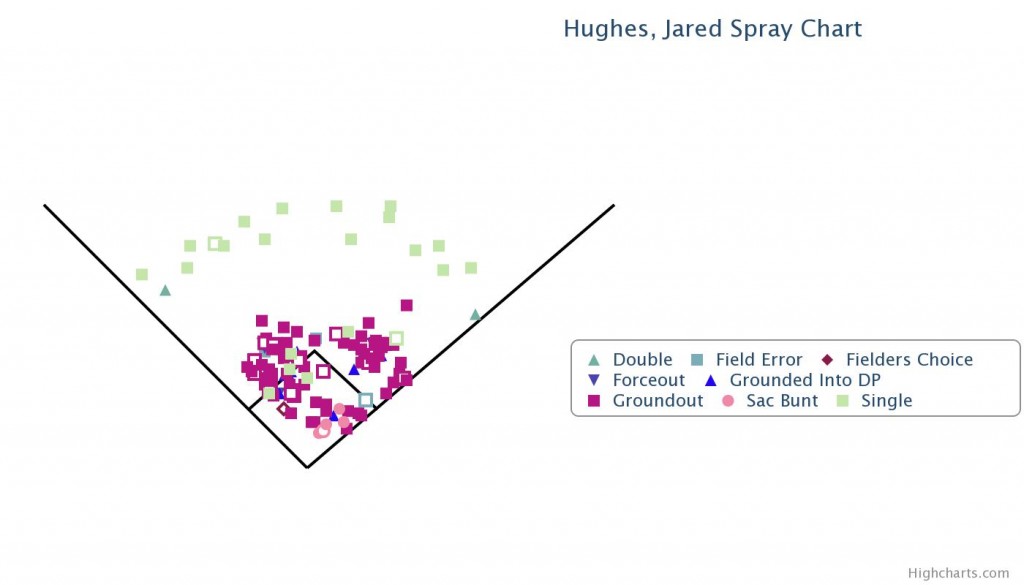This is what I think is great about Jared Hughes: there’s an awfully good chance that he’s walking proof that the Pirates’ front office is a step ahead of most analysis about the relationship between pitching and defense. Over the course of his Pirate career, Hughes has pitched in 170 games and thrown 183 innings. He’s struck out 119 batters and he’s walked 61. He keeps the ball on the ground, with a career 61% ground ball rate and only 14 total home runs allowed. The ground ball rate is great, but there’s nothing exceptional in that profile. Hughes’ career FIP is 4.00, his xFIP is 3.86, and his SIERA is 3.48. Despite that, his ERA is 2.95 and in two of his four years with the Pirates, he’s significantly out-performed his peripherals. In 2012, he had a 2.85 ERA to go with his 4.04 FIP, 3.89 xFIP, and 3.50 SIERA. In 2014, those numbers were 1.96, 3.99, 3.79, and 3.25, respectively.
The basic Jared Hughes Hypothesis is this: Hughes induces a huge number of ground balls, and the ground balls themselves create a reproducible pattern that the Pirates build their shift around. This is a little bit intuitive, though Hughes tends to exceed intuition here. One of the ideas that separates SIERA from FIP and xFIP is that as a pitcher’s ground ball rate has an inverse relationship with their BABIP on ground balls. That is, the higher a pitcher’s ground ball rate, the easier it is for the defense behind him to turn ground balls into outs. Still, Hughes’ ERA outstrips his SIERA by quite a bit, and the difference between the two is staggering in Hughes’ best years. Let’s look at the scatter chart of where Hughes’ groundballs went last year (via Baseball Savant):
 You can see exactly how the Pirates would employ a non-traditional shift with that profile. The result is that Hughes generated 129 ground balls, but only gave up 22 singles and two doubles on them. If you remove the six sacrifice bunts from the equation, hitters had a .195 BABIP on ground balls against Hughes in 2014. Last year, the league as a whole had a .249 BABIP on ground balls. Essentially, Hughes gave up six fewer hits on grounders than the average big league pitcher would have on the same number of ground balls.
You can see exactly how the Pirates would employ a non-traditional shift with that profile. The result is that Hughes generated 129 ground balls, but only gave up 22 singles and two doubles on them. If you remove the six sacrifice bunts from the equation, hitters had a .195 BABIP on ground balls against Hughes in 2014. Last year, the league as a whole had a .249 BABIP on ground balls. Essentially, Hughes gave up six fewer hits on grounders than the average big league pitcher would have on the same number of ground balls.
I’m guessing this bears itself out in strand rate: Hughes entered 18 games last year with runners on base and was often leaned on to get double plays. His strand rate was 78.1% in 2014 and 75.3% for his career. The league average tends to hover around 72-73%. If you assume that the Pirates’ shifts make this reproducible (this is a big assumption), this is a great result for a pitcher with a low strikeout rate.
Hughes’ ground ball magic is a big component of a good Pirate bullpen, as it helps them escape early jams without burning Tony Watson or Mark Melancon. I’m not sure how much of what he did in 2014 is reproducible, but I think you can make a case that it’s more reproducible than you might otherwise suspect from a pitcher with his peripherals.
Hat-tip to Matt Bandi for lending a hand with the research on this post. No, this part doesn’t count towards 500 words. Hey! I make the rules here.
<500 is an ongoing series previewing 2015 for each key Pirate in fewer than 500 words.
Header photo by Justin K. Aller/Getty Images




















